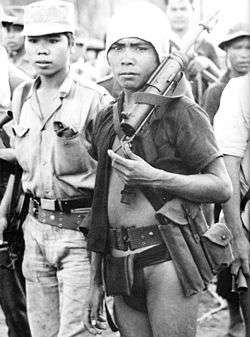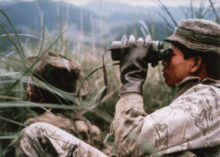Montagnard (Vietnam)
The Montagnard are indigenous peoples of the Central Highlands of Vietnam. The French term Montagnard means "people of the mountain" and is a carryover from the French protectorate period in Vietnam. In Vietnamese, they are known by the term người Thượng (Highlanders)—this term now can also be applied to other minority ethnic groups in Vietnam or Người dân tộc thiểu số (literally, "minority people"). Earlier they were referred to pejoratively as the mọi.[1] Sometimes the term degar is used for the group as well. Most of those living in America refer to themselves as Montagnards,[2] while those living in Vietnam refer to themselves by their individual tribe.
The Montagnards are most covered in English-language scholarship for their participation in the Vietnam War, where they were heavily recruited by South Vietnam due to their antipathy to the strong centralized state offered by North Vietnam as well as communism's hostility toward religion, as the Montagnards were Christian at a much higher proportion than that of the Viet people.
Ethnic groups
Below is a list of officially recognized ethnic groups in Vietnam that are indigenous to the Central Highlands and nearby areas, with a total population of approximately 2.25 million. They speak Austroasiatic languages of the Katuic and Bahnaric, as well as Chamic languages (which belong to the Austronesian language family). Population statistics are from the 2009 Vietnam Population Census.
- Katuic speakers
- Bru (2009 population: 74,506): Quảng Trị Province
- Cơ Tu (2009 population: 61,588): Quảng Nam Province
- Tà Ôi (2009 population: 43,886): Thừa Thiên-Huế Province and Quảng Trị Province
- Bahnaric speakers
- West Bahnaric
- Brâu (2009 population: 397): Kon Tum Province
- East Bahnaric
- Co (2009 population: 33,817): Quảng Ngãi Province
- North Bahnaric
- Xơ Đăng (2009 population: 169,501): Kon Tum Province and Quảng Nam Province
- Hrê (2009 population: 127,420): Quảng Ngãi Province
- Rơ Măm (2009 population: 436): Kon Tum Province
- Central Bahnaric
- Ba Na (2009 population: 227,741): Gia Lai Province and Kon Tum Province
- Giẻ Triêng (2009 population: 50,962): Kon Tum Province and Quảng Nam Province
- South Bahnaric
- Chơ Ro (2009 population: 26,855): Đồng Nai Province
- Cờ Ho (2009 population: 166,112): Lâm Đồng Province
- Mạ (2009 population: 41,405): Lâm Đồng Province
- X’Tiêng (2009 population: 85,436): Bình Phước Province
- Mnông (2009 population: 102,741): Đắk Lắk Province and Đắk Nông Province
- West Bahnaric
- Chamic speakers
- Chăm (2009 population: 161,729): Ninh Thuận Province and Bình Thuận Province
- Chu Ru (2009 population: 19,314): Lâm Đồng Province
- Ê Đê (2009 population: 331,194): Đắk Lắk Province
- Gia Rai (2009 population: 411,275): Gia Lai Province
- Ra Glai (2009 population: 122,245): Ninh Thuận Province and Khánh Hòa Province
Listed by province, from north to south as well as west to east:
- Quảng Trị Province: Bru (Katuic), Tà Ôi (Katuic)
- Thừa Thiên-Huế Province: Tà Ôi (Katuic)
- Quảng Nam Province: Cơ Tu (Katuic), Xơ Đăng (North Bahnaric), Giẻ Triêng (Central Bahnaric)
- Quảng Ngãi Province: Hrê (North Bahnaric), Co (East Bahnaric)
- Kon Tum Province: Giẻ Triêng (Central Bahnaric), Ba Na (Central Bahnaric), Xơ Đăng (North Bahnaric), Rơ Măm (North Bahnaric), Brâu (West Bahnaric)
- Gia Lai Province: Gia Rai (Chamic), Ba Na (Central Bahnaric)
- Đắk Lắk Province: Ê Đê (Chamic), Mnông (South Bahnaric)
- Khánh Hòa Province: Ra Glai (Chamic)
- Đắk Nông Province: Mnông (South Bahnaric)
- Lâm Đồng Province: Chu Ru (Chamic), Mạ (South Bahnaric), Cờ Ho (South Bahnaric)
- Ninh Thuận Province: Ra Glai (Chamic), Chăm (Chamic)
- Bình Phước Province: X’Tiêng (South Bahnaric)
- Đồng Nai Province: Chơ Ro (South Bahnaric)
- Bình Thuận Province: Chăm (Chamic)
History

In 1962, the population of the Montagnard people in the Central Highlands was estimated to number as many as one million.[3] Today, the population is approximately four million, of whom about one million are Montagnards. The 30 or so Montagnard tribes in the Central Highlands comprise more than six different ethnic groups who speak languages drawn primarily from the Malayo-Polynesian, Tai, and Austroasiatic language families. The main tribes, in order of population, are the Jarai, Rade, Bahnar, Koho, Mnong, and Stieng.
Originally inhabitants of the coastal areas of the region, they were driven to the uninhabited mountainous areas by invading Vietnamese and Cambodians beginning prior to the 9th century.
French missionaries converted some Montagnard to the Catholic Church in the nineteenth century, but American missionaries converted more to Protestantism in the 1930s. Of the approximately one million Montagnard, close to half are Protestant, and around 200,000 are Roman Catholic. This made Vietnam's Communist Party suspicious of the Montagnard, particularly during the Vietnam War, since it was thought that they would be more inclined to help the predominantly Christian American forces.
In 1950 the French government established the Central Highlands as the Pays Montagnard du Sud (PMS) under the authority of Vietnamese Emperor Bảo Đại, whom the French had installed as nominal chief of state in 1949 as an alternative to Ho Chi Minh's Democratic Republic of Vietnam. In the mid-1950s, the once-isolated Montagnard began experiencing more contact with outsiders after the Vietnamese government launched efforts to gain better control of the Central Highlands and, following the 1954 Geneva Accord, new ethnic minorities from North Vietnam moved into the area. As a result of these changes, Montagnard communities felt a need to strengthen some of their own social structures and to develop a more formal shared identity. When the French withdrew from Vietnam and recognized a Vietnamese sovereignty, Montagnard political independence was drastically diminished.
The Montagnard have a long history of tensions with the Vietnamese majority. While the Vietnamese are themselves heterogeneous, they generally share a common language and culture and have developed and maintained the dominant social institutions of Vietnam. The Montagnard do not share that heritage. There have been conflicts between the two groups over many issues, including land ownership, language and cultural preservation, access to education and resources, and political representation.
In 1958, the Montagnard launched a movement known as BAJARAKA (the name is made up of the first letters of prominent tribes; similar to the later Nicaraguan Misurasata) to unite the tribes against the Vietnamese. There was a related, well-organized political and (occasionally) military force within the Montagnard communities known by the French acronym, FULRO, or United Front for the Liberation of Oppressed Races. FULRO's objectives were autonomy for the Montagnard tribes.
.jpg)
As the Vietnam War began to loom on the horizon, both South Vietnamese and American policy makers sought to begin training troops from minority groups in the Vietnamese populace. The U.S. Mission to Saigon sponsored the training of the Montagnard in unconventional warfare by American Special Forces.[4] These newly trained Montagnard were seen as a potential ally in the Central Highlands area to stop Viet Cong activity in the region and a means of preventing further spread of Viet Cong sympathy.[5] Later, their participation would become much more important as the Ho Chi Minh trail, the North Vietnamese supply line for Viet Cong forces in the south, grew. The U.S. military, particularly the Special Forces, developed base camps in the area and recruited the Montagnard. Because of their quiet resolve and skills in tracking, roughly 40,000 fought alongside American soldiers and became a major part of the U.S. military effort in the Highlands and I Corps, the northernmost region of South Vietnam.[6]
In 1967, the Viet Cong slaughtered 252 Montagnard in the village of Dak Son, home to 2,000 Highlanders, known as the Đắk Sơn massacre, in revenge for the Montagnard's support and allegiance with South Vietnam. In 1975, thousands of Montagnard fled to Cambodia after the fall of Saigon to the North Vietnamese Army, fearing that the new government would launch reprisals against them because they had aided the U.S. Army. The U.S. military resettled some Montagnard in the United States, primarily in North Carolina, but these evacuees numbered less than 2,000. In addition, the Vietnamese government has steadily displaced thousands of villagers from Vietnam's central highlands, to use the fertile land for coffee plantations.
Montagnard and Chinese officers from 1976 and 1979 were purged from the Vietnam People's Army.[7]
Vietnam's south and center highlands were subjected to systematic state backed settlement by ethnic Vietnamese Kinh people. The original peoples of the Central Highlands experienced ruin during and after the Vietnam War; in the worst cases, they were driven from their land and became refugees.[8] In 2003, the group gained admittance to the Unrepresented Nations and Peoples Organization as the "Degar-Montagnards", but this membership was discontinued in 2016.[9]
Outside of southeast Asia, the largest community of Montagnards in the world is located in Greensboro, North Carolina, US.[2] Greensboro is also the home of several community and lobbying organizations, such as the Montagnard Foundation, Inc.
See also
References
- Although the term moi was derogatory in Vietnamese, meaning "savages", it was not so used in European sources. H. Maître (1909) Les Régions Moi du Sud-lndochinois: Le plateau de Darlac
- "MONTAGNARDS" (PDF). August 2008.
- Jackson, Larry R. (1969), "The Vietnamese Revolution and the Montagnards", Asian Survey, Vol 9, No. 5, pp. 315-315
- Onion, Rebecca (November 27, 2013). "The Snake-Eaters and the Yards". Slate Magazine.
- Kelly, Francis John (1989) [1973]. History of Special Forces in Vietnam, 1961-1971. Washington, D.C.: United States Army Center of Military History. pp. 6–7. CMH Pub 90-23.
- Big Picture: Operation Montagnard. U.S. Army Audiovisual Center. 1966.
- Stephen Peter Rosen (1996). Societies and Military Power: India and Its Armies. Cornell University Press. pp. 219–. ISBN 0-8014-3210-3.
- James A. Anderson (20 December 2012). The Rebel Den of Nung Tri Cao: loyalty and identity along the Sino-Vietnamese frontier. University of Washington Press. pp. 172–. ISBN 978-0-295-80077-6.
- https://unpo.org/members/20847
Books
- Sidney Jones, Malcolm Smart, Joe Saunders, HRW. (2002). Repression of Montagnards: Conflicts Over Land and Religion in Vietnam's Central Highlands. Human Rights Watch. ISBN 1-56432-272-6.
- United States Congress. Senate. Committee on Foreign. (1998). The Plight of the Montagnards: Hearing Before the Committee on Foreign Relations, United States Relations, Original from the Library of Congress .
Further reading
- Condominas, Georges. We Have Eaten the Forest: The Story of a Montagnard Village in the Central Highlands of Vietnam. New York: Hill and Wang, 1977. ISBN 0-8090-9672-2.
- Montagnard Foundation. Human Rights Violations: Montagnard Foundation Report, 2001: Report on the Situation of Human Rights Concerning the Montagnards or Degar Peoples of Vietnam's Central Highlands. Spartanburg, South Carolina: The Foundation, 2001.
- Montagnard Foundation. History of the Montagnard/Degar People: Their Struggle for Survival and Rights Before International Law. Spartanburg, South Carolina: The Foundation, 2001.
External links
| Wikimedia Commons has media related to Montagnard. |
